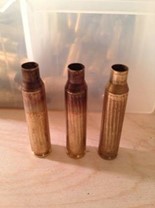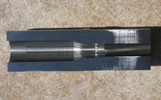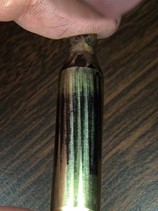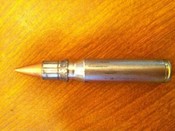Head Ripping Issue Caused by a Fluted Chamber
|

Casings fired out of a fluted chamber. Notice the visible fluting on them.

Illustration depicting how a fluted chamber uses the gases generated during firing to help extract the casing from the weapon.

Image of a fluted chamber.

Picture of one of the casings fired by the shooter. Derek coated it with Sharpie and rubbed off the Sharpie so only the markings in the valleys of the fluting remained.

Picture of one of a round that was inserted into a chamber in which a section of the previous round was lodged in the chamber. he casings fired by the shooter. Derek coated it with Sharpie and rubbed off the Sharpie so only the markings in the valleys of the fluting remained.
|
Recently a shooter sent us their fired Peterson Cartridge .260 Remington casings to make us aware of an issue that they were having with the brass. The casings had chunks missing out of the heads. This had us concerned that the case-heads were splitting, cracking, or had some other unknown issue. Derek Peterson, the president here at Peterson Cartridge, investigated the issue and ultimately found that the cause was due to the casings being shot out of a “fluted chamber”. We thought this information would be valuable for fellow shooters and wanted to share what we learned.
Fluted Chambers
The most well-known manufacturer who employs fluted chambers is H&K who use them on their “H&K 91” rifles. There are pros and cons to fluted chambers as compared to a standard chamber. The main benefit is that they use the gas from inside of the fired casing as a type of “lubrication” for the casing, which aids in its extraction from the chamber.
One of the cons of a fluted chamber is that they do not tend to be compatible with “commercial casings”. The reason for this is that fluted chambers were designed around Mil Spec casings. Mil Spec casings have thicker walls and a smaller internal volume. The reason this has an effect when a casing is fired through a fluted chamber is because the Mil Spec casing, with its thicker walls, doesn’t tend to expand as much when it is fired. Because it doesn’t expand as much, it is less likely to expand into the flutes of the chamber. If a casing being shot through the fluted chamber expands into the flutes of the chamber with too much force, the casing will stick in the weapon. This sticking will likely become exaggerated when the weapon becomes dirty from the carbon build-up during firing.
In the picture to the left, you can see the grooves on one of the casings sent to us by the concerned shooter. These grooves are what tipped Derek off to the casings being fired out of a fluted chamber.
The Damage Done
Derek concluded that the shooter fired their rounds through a fluted chamber which had been reamed on the very bottom of SAAMI spec to improve the weapon’s accuracy. This lead to the cases experiencing a very high pressure when fired. The high pressure expanded the casing sidewalls into the flutes of the chamber, causing the casings to become hard to extract and eventually stick once the weapon became dirty from the carbon generated during firing. The casings likely expanded more than Mil Spec casings due to their thinner walls and larger internal volumes, as is customary with commercial casings. The casings did hold up very well, which is evidenced by them not tearing in half like some commercial casings do when fired through a fluted chamber.
Once the casings became stuck in the chamber of the weapon, the extractor had no option but to either slip off the rim of the casing, or rip the rim of the casing off. In this case, it was the latter of the two, and the casing rim was ripped off. Please keep in mind that putting a casing in the situation where it is stuck in the chamber of a weapon so well that the extractor rips the head of the casing off, can result in a casing being ripped in half leaving a section of the casing in the chamber of the weapon.
Viable Solutions
Derek offered the following possible solutions to the shooter:
- Change the chamber away from a fluted design. This would prevent the casings from lodging in the flutes of the chamber of the weapon.
- Increase the overall size of the chamber. This will help reduce the amount the casing flows into the fluting. (This option runs the risk of possible reducing the accuracy of the weapon.)
- Adjust the gas cycling system / timing of the weapon. There might be a chance the weapon is trying to eject the casing before it has finished expanding and retracting from firing. This could best be described as inserting a “delay” after firing before the casing is extracted.
- Reduce the casing internal peak pressure by using a lighter bullet or reducing the charge put into the casing. This should cause the casings not to fill into the fluting of the chamber as tightly. (This is the solution Derek considered the best.)
- Polish the inside of the chamber to a much finer finish. This should reduce the friction in the chamber, and make the casing easier to extract. (Another option that Derek considered to be okay.)
What Derek concluded is that a weapon with a fluted chamber that is being used for precision shooting will be temperamental about what type of ammo is being fired. The issue that the shooter was seeing in his Peterson Cartridge .260 Remington brass was a result of him shooting a high-pressure load through an incompatible chamber.
The long-distance competition shooters we sell to want to know everything they possibly can about the “how” and “why” casings perform the way they do. We at Peterson Cartridge are happy to contribute to the conversation.
About the author
Ben Preston
Ben Preston serves as Inspection and Shipping Manager at Peterson Cartridge. In this role, Ben is responsible for a stringent visual inspection process where he checks that every casing is free of defect. Ben oversees incoming and finished goods inventory and works to meet shipping deadlines.
Ben is an avid hunter and shooter with a passion and appreciation for high quality cartridges.





